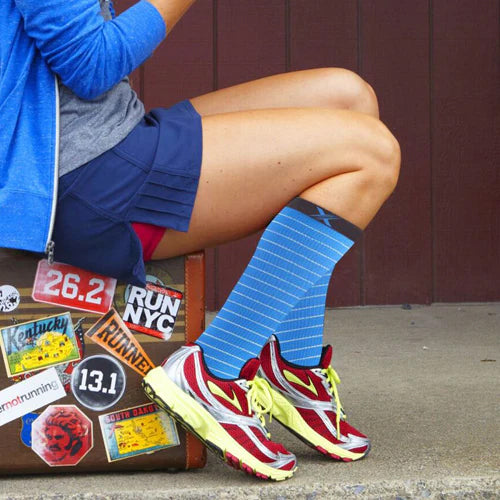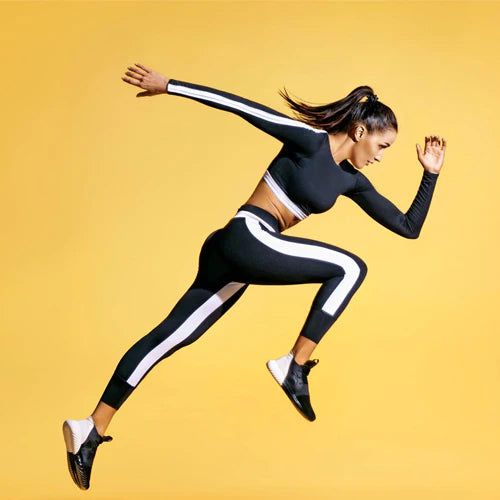You’ve probably heard about them. You may even own a pair. And still, if someone asked you to run down all the benefits of compression socks and explain who needs them most, you’d shrug your shoulders and recommend consulting a doctor.
If you don’t use them regularly, there’s a good chance you think these stockings are strictly clinical. Like a neck brace or hearing aids, people assume compression socks are a remedy for a problem, the next step after your body has taken a turn for the worse. This thinking isn’t completely wrong, but it skips right over the importance of preventative care and comfort. It also ignores the fact that today’s compression socks can be pretty stylish.
The truth is people who lead an active lifestyle and have a clean bill of health stand to gain as much as anyone from a little well-timed compression. Understanding the actual uses of compression socks will clarify the benefits, helping you see how a quality pair can improve your workouts, health, and overall comfort.
The Major Benefits of Compression Socks
While everyone has varied personal needs, there are a handful of general benefits that wearing compression socks can provide for pretty much anyone.
Reduced Soreness
It’s hard to overstate the importance of good circulation. When blood gets where it needs to go, muscles get oxygen quickly. Whether you run competitively or just go for the occasional jog, improved blood flow has an obvious and immediate impact on how good you feel.
Pain is a guaranteed result when you strain your muscles for a long enough period. Tearing muscle fibers and concentrating lactic acid result in that stiff-legged walking every athlete is familiar with. While you can’t eliminate the post-workout soreness, you can dial it back significantly by increasing the flow of oxygen to those active muscles.
If you’ve watched a basketball game in the last decade, you’ve noticed how more and more professional players are sporting compression gear. From tights to socks to arm sleeves, they take every possible step to improve circulation. A rigorous schedule of high-level competition doesn’t leave much time to recover from sore muscles, and these players clearly understand the benefit of wearing compression legwear and sleeves.
Improved Recovery Time
In addition to the advantages provided during strenuous activity, compression socks help speed up your recovery. Blood flow and oxygen are just as important in the aftermath of a workout as they are at peak exertion. When you wear compression socks as part of your post-exercise routine, you improve circulation and get a jump on clearing out the lactic acid trying to stow away in your muscle tissue.
Athletes do a lot of things to help their bodies recover, such as:
- Ice baths
- Hot tubs
- Anti-inflammatories
These practices have a known effect on recovery and they all have overlap with the health benefits of compression socks. The goal of boosting circulation, reducing swelling, and minimizing pain make circulation gear an excellent supplement, if not a replacement, for these more traditional recovery techniques.
Fighting the painful cramps that make the hours and days after a long run extra tedious is also vital. It enables you to maintain a steadier gate and avoid straining supporting muscles that have to pick up the slack when soreness causes you to walk funny. Although it may not seem like it, how you recover affects your physical comfort just as much as how you exercise.
Medical Benefits
If there’s one piece of common knowledge about compression socks, it’s that they’re used to address venous issues. People suffering from varicose veins have used them for years. This is probably the main association, and it’s the reason a lot of people who should use compression gear think the benefits don’t apply to them.
In addition to the circulation issues that come with age, doctors prescribe compression socks to help reduce the risk of blood clots. Anyone on prolonged bed rest after surgery, or undergoing hormone treatment, or with a family history of clotting may use compression as a precautionary measure.
Even those who don’t have a diagnosed risk of clotting can take preventative steps when flying or staying seated for eight hours a day at work. With so many desk-bound jobs keeping people sedentary, it’s hard to find modern workers who don’t spend half the day cutting off circulation to their lower legs. No matter how good your posture is from the waist up, full-time desk jobs are bad news when it comes to healthy blood flow.
Meanwhile, service industry workers, nurses, and everyone else who works a long day on their feet tends to see improved comfort with compression socks. While steady movement takes care of the clotting issue, it leads to aching feet and tired legs. Good circulation helps combat the discomfort, and compression socks will keep blood flowing through those lower extremities.
As with anything related to your health, an ounce of prevention is worth a pound of cure. In this case, the cost of some snazzy compression socks is definitely worth the copay you lose each time you see a doctor about blood clots or leg swelling.
Comfort
With the regular use of compression socks, preventative care comes with a side general comfort in your day-to-day life. It feels better to move when your muscles have all the oxygen they want. When blood circulates as it should, your feet don’t tingle and your legs stay fresh. Snug, breathable socks might just be the most comfortable thing you can wear on any given day.
You can also find comfort in liking how you look. Once you move past the medical stigma and see that compression socks come in all sorts of colors, patterns, and styles, you’ll feel more comfortable putting them on. Form-fitting socks also bring that sleek, smooth aesthetic - a faster look for faster running. Combine that with durable material that wicks away sweat to keep moisture from building up, and you have every reason to make these socks part of your standard athletic ensemble.
You don’t have to be old to wear compression socks and you certainly don’t have to be injured to take advantage of their many benefits. With an eye on staying active and getting the most out of your daily routine, these socks make a great addition to your wardrobe. The fact that they look stylish is just icing on the cake.





